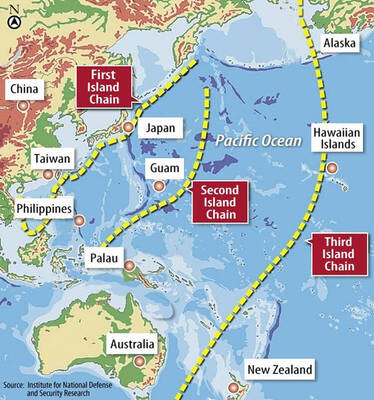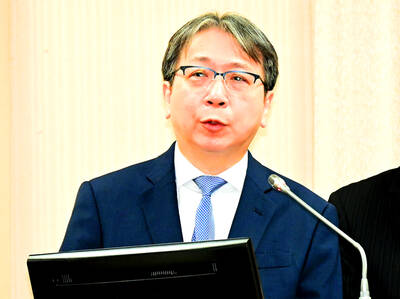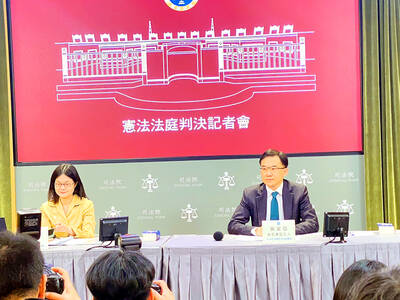President Ma Ying-jeou (馬英九) yesterday visited Chiayi County to promote the government’s proposed economic cooperation framework agreement (ECFA) to local farmers, promising to defend the rights of farmers and laborers.
Speaking in Taiwanese, Ma said officials from the Mainland Affairs Council (MAC) and the Ministry of Economic Affairs had visited many cities and counties to explain the importance of ECFA to the people, and the government would strive to help the public gain a better understanding of what an ECFA is.
“We understand that many people are concerned about the ECFA. The government will keep the promise of not opening Taiwan to more Chinese agricultural products,” Ma said yesterday.
Vice President Vincent Siew (蕭萬長) and Premier Wu Den-yih (吳敦義) will make frequent visits to southern Taiwan to explain the ECFA using Taiwanese, he said.
Ma stressed the importance of signing an ECFA with China, Taiwan’s biggest trading partner, and said the government expects that once an ECFA is signed, barriers to Taiwan’s efforts to sign free trade agreements with ASEAN countries would be reduced.
In response to Democratic Progressive Party (DPP) Chairperson Tsai Ing-wen’s (蔡英文) reservations about the government signing an ECFA, the Chinese Nationalist Party (KMT) yesterday challenged Tsai about her opposition to setting up a cross-strait task force in the legislature when she served as MAC chairwoman.
“If the DPP opposes the ECFA, please present an alternative solution to the nation’s isolation from regional economic integration,” KMT Spokesman Lee Chien-jung (李建榮) said.
Meanwhile, Legislative Speaker Wang Jin-pyng (王金平) yesterday repeated his support for the establishment of a task force on cross-strait affairs in the legislature to monitor cross-strait policies and react to changes in the situation.
“As cross-strait interaction is well underway, no single legislative committee can handle all the issues alone. These concern almost all the legislature’s eight committees. In view of this, it’s necessary to establish a cross-strait task force,” Wang said.
“At the moment, the legislature should actively participate [before a cross-strait policy is made] and in its oversight afterwards,” he said.
Wang made the remarks after an inter-party negotiation session on the DPP caucus’ request to set up a task force.
Responding to media reports that Ma opposed the proposal, Wang said that he hadn’t heard that from the president.
During the inter-party negotiations, DPP caucus whips and their KMT counterparts failed to resolve their differences on the task force proposal.
KMT and DPP caucus representatives agreed that the task force, if it is to be set up, should serve as a platform for communication between the executive branch and the legislative branch, but they were at odds over whether it would be able to make binding resolutions.
DPP caucus whip Chen Ying (陳瑩) said the party would draw an outline for establishing the task force as a basis for discussion with the KMT in the next round of inter-party negotiations.
KMT caucus whip Lin Hong-chi (林鴻池) said the caucus needed to clarify doubts surrounding the establishment of the task force.
“If the executive branch needs to consult with the task force before a policy is made, there is the possibility of the legislature infringing on executive power. Furthermore, if the task force is able to make binding resolutions, conflicts of authority may arise between the task force and the legislature’s statutory committees,” Lin said.
DPP legislator Ker Chien-ming (柯建銘) said that the party caucus opposed the idea touted by the KMT of holding a plenary legislative session to monitor cross-strait negotiations.
Straits Exchange Foundation (SEF) Chairman Chiang Pin-kung (江丙坤) had failed to report to the legislative plenary session on each occasion before cross-strait talks, and the economic treaties inked during the talks were enacted without legislative approval, so legislative plenary sessions were clearly insufficient to monitor the policies, Ker said.
He accused the KMT caucus of refusing to form a task force to effectively monitor cross-strait policies but confusing the matter by holding a plenary session.
In related news, the Presidential Office on Tuesday commented on why foreign media had not been allowed to attend a briefing by Ma on the ECFA.
In an e-mail to the Taipei Times, Taiwan Foreign Correspondents’ Club (TFCC) president Robin Kwong (鄺彥暉) said that after receiving a complaint letter from the TFCC, the Presidential Office told him that the meeting was intended as a “gathering between the president and the local journalists’ association” and was not a press event.
“It was therefore not open to not just foreign media, but also local media who were not members of the journalists’ association,” Kwong said.
As a last-minute solution, foreign media were allowed to watch the event on a video link at the Presidential Office press room.
Kwong said the Presidential Office was focusing on improving its communication on ECFA-related matters with the domestic audience after being criticized for its handling of the US beef issue in recent months.
“If the president [is] going to talk about an issue as important as [an] ECFA, then it is no longer just a social gathering,” Kwong told the Presidential Office, adding that the TFCC was “especially concerned” because Tuesday’s briefing was not just a one-off event, but a regular monthly briefing.
“The Presidential Office’s response was that they would not change the arrangements for yesterday [Tuesday], but that President Ma would hold a similar briefing with the TFCC in early April,” Kwong said.
ADDITIONAL REPORTING BY RICH CHANG

The US government has signed defense cooperation agreements with Japan and the Philippines to boost the deterrence capabilities of countries in the first island chain, a report by the National Security Bureau (NSB) showed. The main countries on the first island chain include the two nations and Taiwan. The bureau is to present the report at a meeting of the legislature’s Foreign Affairs and National Defense Committee tomorrow. The US military has deployed Typhon missile systems to Japan’s Yamaguchi Prefecture and Zambales province in the Philippines during their joint military exercises. It has also installed NMESIS anti-ship systems in Japan’s Okinawa

TRAGEDY STRIKES TAIPEI: The suspect died after falling off a building after he threw smoke grenades into Taipei Main Station and went on a killing spree in Zhongshan A 27-year-old suspect allegedly threw smoke grenades in Taipei Main Station and then proceeded to Zhongshan MRT Station in a random killing spree that resulted in the death of the suspect and two other civilians, and seven injured, including one in critical condition, as of press time last night. The suspect, identified as a man surnamed Chang Wen (張文), allegedly began the attack at Taipei Main Station, the Taipei Fire Department said, adding that it received a report at 5:24pm that smoke grenades had been thrown in the station. One man in his 50s was rushed to hospital after a cardiac arrest

ON ALERT: Taiwan’s partners would issue warnings if China attempted to use Interpol to target Taiwanese, and the global body has mechanisms to prevent it, an official said China has stationed two to four people specializing in Taiwan affairs at its embassies in several democratic countries to monitor and harass Taiwanese, actions that the host nations would not tolerate, National Security Bureau (NSB) Director-General Tsai Ming-yen (蔡明彥) said yesterday. Tsai made the comments at a meeting of the legislature’s Foreign Affairs and National Defense Committee, which asked him and Minister of National Defense Wellington Koo (顧立雄) to report on potential conflicts in the Taiwan Strait and military preparedness. Democratic Progressive Party (DPP) Legislator Michelle Lin (林楚茵) expressed concern that Beijing has posted personnel from China’s Taiwan Affairs Office to its

‘ILLEGAL RULING’: The KMT and the TPP slammed the Constitutional Court judgement, saying it contravened the law and was trying to clear the way for a ‘green dictatorship’ The Constitutional Court yesterday ruled that amendments to the Constitutional Court Procedure Act (憲法訴訟法) passed by the Legislative Yuan last year are unconstitutional, as they contravene due legislative process and separation of powers. The Legislative Yuan on Dec. 20 last year passed amendments stipulating that no fewer than 10 grand justices must take part in deliberations of the Constitutional Court, and at least nine grand justices must agree to declare a law unconstitutional. The Executive Yuan on Jan. 2 requested that lawmakers reconsider the bill, but the Legislative Yuan, under a combined majority of Chinese Nationalist Party (KMT) and Taiwan People’s Party